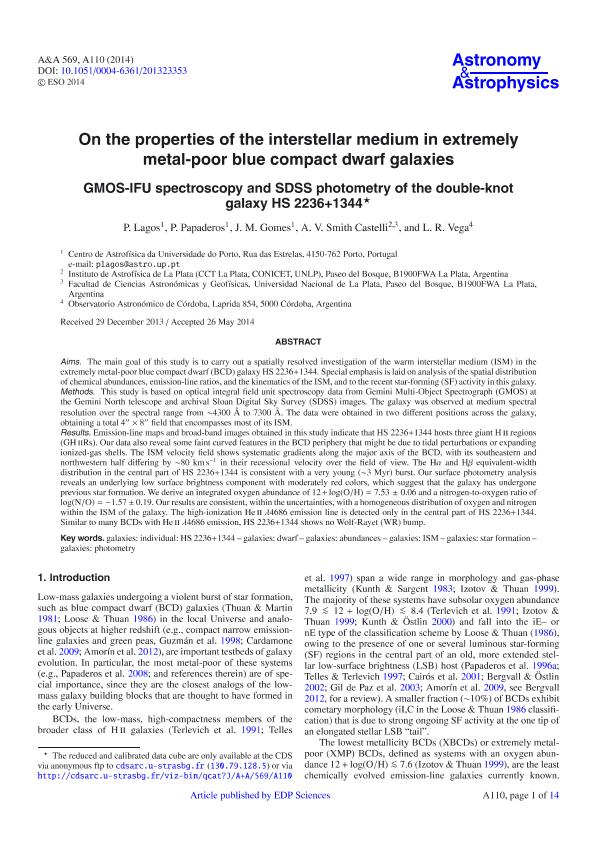Artículo
On the properties of the interstellar medium in extremely metal-poor blue compact dwarf galaxies: GMOS-IFU spectroscopy and SDSS photometry of the double-knot galaxy HS 2236+1344
Fecha de publicación:
05/2014
Editorial:
Edp Sciences
Revista:
Astronomy And Astrophysics
ISSN:
0004-6361
Idioma:
Inglés
Tipo de recurso:
Artículo publicado
Clasificación temática:
Resumen
Aims. The main goal of this study is to carry out a spatially resolved investigation of the warm interstellar medium (ISM) in the extremely metal-poor blue compact dwarf (BCD) galaxy HS 2236+1344. Special emphasis is laid on analysis of the spatial distribution of chemical abundances, emission-line ratios, and the kinematics of the ISM, and to the recent star-forming (SF) activity in this galaxy.
Methods. This study is based on optical integral field unit spectroscopy data from Gemini Multi-Object Spectrograph (GMOS) at the Gemini North telescope and archival Sloan Digital Sky Survey (SDSS) images. The galaxy was observed at medium spectral resolution over the spectral range from ∼4300 Å to 7300 Å. The data were obtained in two different positions across the galaxy, obtaining a total 4 × 8 field that encompasses most of its ISM.
Results. Emission-line maps and broad-band images obtained in this study indicate that HS 2236+1344 hosts three giant H ii regions (GH iiRs). Our data also reveal some faint curved features in the BCD periphery that might be due to tidal perturbations or expanding ionized-gas shells. The ISM velocity field shows systematic gradients along the major axis of the BCD, with its southeastern and
northwestern half differing by ∼80 km s−1 in their recessional velocity over the field of view. The Hα and Hβ equivalent-width distribution in the central part of HS 2236+1344 is consistent with a very young (∼3 Myr) burst. Our surface photometry analysis reveals an underlying low surface brightness component with moderately red colors, which suggest that the galaxy has undergone previous star formation. We derive an integrated oxygen abundance of 12+log(O/H) = 7.53 ± 0.06 and a nitrogen-to-oxygen ratio of log(N/O) = −1.57 ± 0.19. Our results are consistent, within the uncertainties, with a homogeneous distribution of oxygen and nitrogen
within the ISM of the galaxy. The high-ionization He ii λ4686 emission line is detected only in the central part of HS 2236+1344.
Similar to many BCDs with He ii λ4686 emission, HS 2236+1344 shows no Wolf-Rayet (WR) bump.
Palabras clave:
Galaxies
,
Dwarfs
,
Abundances
,
Spectroscopy
Archivos asociados
Licencia
Identificadores
Colecciones
Articulos(IALP)
Articulos de INST.DE ASTROFISICA LA PLATA
Articulos de INST.DE ASTROFISICA LA PLATA
Citación
Lagos, P.; Papaderos, P.; Gomes, J. M.; Smith Castelli, Analia Viviana; Vega, Luis Rodolfo; On the properties of the interstellar medium in extremely metal-poor blue compact dwarf galaxies: GMOS-IFU spectroscopy and SDSS photometry of the double-knot galaxy HS 2236+1344; Edp Sciences; Astronomy And Astrophysics; 569; 110; 5-2014; 1-14
Compartir
Altmétricas




